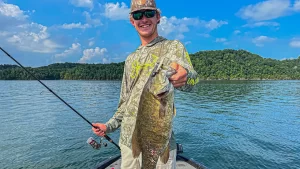Since the initial discovery of northern smallmouth on the St. Lawrence River, there has been an ongoing effort to refine techniques for catching these elusive fish, particularly during the post-spawn period. One of the most effective methods involves using advanced electronics, such as forward-facing sonar, which has proven invaluable for locating and targeting smallmouth in northern waters. The emphasis here is on using a jig head minnow, which has become a go-to setup for this style of fishing.
How to Locate Fish
Unlike bass in the southern United States, northern smallmouth are more responsive to artificial lures, though their nomadic nature post-spawn can make them challenging to locate. These fish are constantly on the move, searching for food sources like gobies and perch. High-percentage areas such as major points, humps, and drains are prime locations to start the search. Using forward-facing sonar is crucial in this scenario, as it is better suited for spotting individual fish, which are not typically grouped in large numbers during this time. By covering water with a trolling motor, anglers can quickly assess the quality and size of the fish in the area.

The Importance of Bait
The presence of baitfish, such as perch, crayfish, or gobies, can often determine whether smallmouth bass will stay in a particular area or move on. Locating these bait sources is key to consistent success, particularly during the post-spawn period. Electronics play a vital role in finding bait, with side and down imaging being the most effective tools for this task. When searching for perch, focusing on contour changes and primary locations can help identify baitfish pods before casting. For gobies and crayfish, which prefer hard structures like rocks, scanning areas between vegetation and rocky outcrops is essential.
Reading the Fish
Understanding the behavior and feeding patterns of smallmouth bass is critical for successful lure presentation. When targeting bass feeding on bottom-dwelling forage such as gobies or crayfish, it is essential to present the bait just above their heads. This requires precision, as these bass often cruise close to the bottom, making them less noticeable on sonar. In contrast, when bass are feeding on perch or other suspended baitfish, they are more likely to respond to mid-strolling techniques. In this case, the bass are typically suspended and more aggressive, making them more likely to chase a minnow-style bait. Adjusting retrieval speed to mimic fleeing baitfish can trigger a bite, making it crucial to maintain the proper cadence.

Lure Selection
With the rise in popularity of mid-strolling techniques, selecting the right jig head and minnow combination has become increasingly important. While color matters, size and weight are the primary factors. The depth and speed at which bass are moving dictate the jig head size. Lighter jig heads, such as 3/16 or 1/4-ounce, are ideal for bass high in the water column, while heavier heads, like 3/8 or 1/2-ounce, are better for deeper or faster-moving fish. Some recommended jig heads include the Queen Tackle Live Sonar Tungsten Jighead and the Keitech Super Round Tungsten Jig Head.
Minnow size is determined by how the fish react to the lure, with adjustments made based on their response. Starting with a 5-inch minnow is common, but the size can be increased or decreased as needed. Matching the hatch by selecting minnows that closely resemble the forage bass are feeding on is often the most effective approach. Some popular choices include the Strike King Baby Z-Too and the Z-Man Scented Jerk Shadz.
Incorporating mid-strolling techniques into regular fishing routines can lead to highly productive outings, especially during the post-spawn period. With proper lure selection and an understanding of fish behavior, anglers can enjoy successful and enjoyable days on the water.
Images/Source: Wired2Fish





